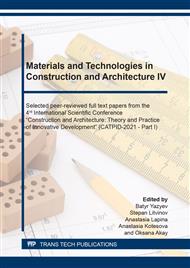[1]
T.T. Le, S.A. Austin, S. Lim, R.A. Buswell, A.G.F. Gibb, T.Thorpe, Mix design and fresh properties for high-performance printing concrete. Mater. Struct. Constr. 45 (2012)1221-1232. doi.org/10.1617/s11527-012-9828-z.
DOI: 10.1617/s11527-012-9828-z
Google Scholar
[2]
J. Ouyang, Y. Tan, D.J. Corr, S.P. Shah, The thixotropic behavior of fresh cement asphalt emulsion paste. Constr. Build. Mater. 114 (2016) 906-912. doi.org/10.1016/j.conbuildmat. 2016.04.024.
DOI: 10.1016/j.conbuildmat.2016.04.024
Google Scholar
[3]
Y. Qian, S. Kawashima S, Distinguishing dynamic and static yield stress of fresh cement mortars through thixotropy. Cem. Concr. Compos. 86 (2018) 288-296. doi.org/10.1016/j.cemconcomp.2017. 11.019.
DOI: 10.1016/j.cemconcomp.2017.11.019
Google Scholar
[4]
N. Roussel, H. Bessaies-Bey, S. Kawashima, D. Marchon, K. Vasilic, R. Wolfs, Recent advances on yield stress and elasticity of fresh cement-based materials. Cem. Concr. Res. 124 (2019) 105798. doi.org/10.1016/j.cemconres.2019.105798.
DOI: 10.1016/j.cemconres.2019.105798
Google Scholar
[5]
V. Mechtcherine, F.P. Bos, A. Perrot, W.R. Leal da Silva, V.N. Nerella, S. Fataei R.J.M. Wolfs, M. Sonebi, N. Roussel, Extrusion-based additive manufacturing with cement-based materials –Production steps, processes, and their underlying physics: A review. Cem. Concr. Res. 132 (2020) 106037. doi.org/10.1016/j.cemconres.2020.106037.
DOI: 10.1016/j.cemconres.2020.106037
Google Scholar
[6]
T. T. Le, S. A. Austin, S. Lim, R. A. Buswell, R. Law A. G. F. Gibb, T. Thorpe, Hardened properties of high-performance printing concrete. Cem. Concr. Res. 42 (2012) 558-566. doi.org/10.1016/j.cemconres.2011.12.003.
DOI: 10.1016/j.cemconres.2011.12.003
Google Scholar
[7]
A. Perrot, D. Rangeard, A. Pierre, Structural built-up of cement-based materials used for 3Dprintingextrusion techniques. Mater. Struct. Constr. 49 (2016) 1213-1220. doi.org/10.1617/s11527-015-0571-0.
DOI: 10.1617/s11527-015-0571-0
Google Scholar
[8]
Siwei Ma, Ye Qian, Shiho Kawashima, Experimental and modeling study on the non-linear structural build-up of fresh cement pastes incorporating viscosity modifying admixtures. Cem. Concr. Res. 108 (2018) 1-9. doi.org/10.1016/j.cemconres.2018.02.022.
DOI: 10.1016/j.cemconres.2018.02.022
Google Scholar
[9]
Yu Zhang, Yunsheng Zhang, Wei She, Lin Yang, Guojian Liu, Yonggan Yang, Rheological and harden properties of the high-thixotropy 3D printing concrete. Constr. Build. Mater. 201 (2019) 278-285. doi.org/10.1016/j.conbuildmat.2018.12.061.
DOI: 10.1016/j.conbuildmat.2018.12.061
Google Scholar
[10]
Bilal Baz, Georges Aouad, Joelle Kleib, David Bulteel, Sébastien Remond, Durability assessment and microstructural analysis of 3D printed concrete exposed to sulfuric acid environments. Constr. Build. Mater. 290 (2021) 123220. doi.org/10.1016/j.conbuildmat. 2021.123220.
DOI: 10.1016/j.conbuildmat.2021.123220
Google Scholar
[11]
Shaodan Hou, Zhenhua Duan, Jianzhuang Xiao, Jun Ye, A review of 3D printed concrete: Performance requirements, testing measurements and mix design. Constr. Build. Mater. 273 (2021) 121745. doi.org/10.1016/j.conbuildmat.2020.121745.
DOI: 10.1016/j.conbuildmat.2020.121745
Google Scholar
[12]
Z. Toutou, N. Roussel, C. Lanos,The squeezing test: A tool to identify firm cement-based material's rheological behavior and evaluate their extrusion ability. Cem. Concr. Res. 35 (2005) 1891-1899. doi.org/10.1016/j.cemconres.2004.09.007.
DOI: 10.1016/j.cemconres.2004.09.007
Google Scholar
[13]
G.S. Slavcheva, M.A. Shvedova D.S. Babenko, Analysis and Criteria Assessment of Rheological Behavior of Mixes for Construction 3-D Printing. BuildingMaterials 766 (2018) 34-40. doi.org/10.31659/0585-430x-2018-766-12-34-40.
DOI: 10.31659/0585-430x-2018-766-12-34-40
Google Scholar
[14]
G.S. Slavcheva, O.V. Artamonova, Rheological behavior and mix design for 3D-printable cement paste. Key Eng. Mater. 799 (2019) 282–287.
DOI: 10.4028/www.scientific.net/kem.799.282
Google Scholar


